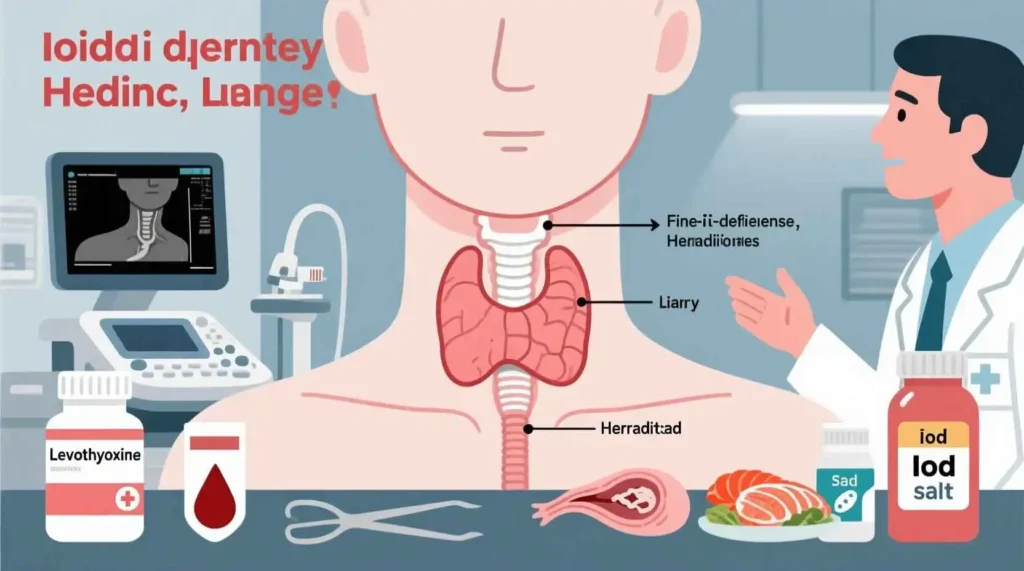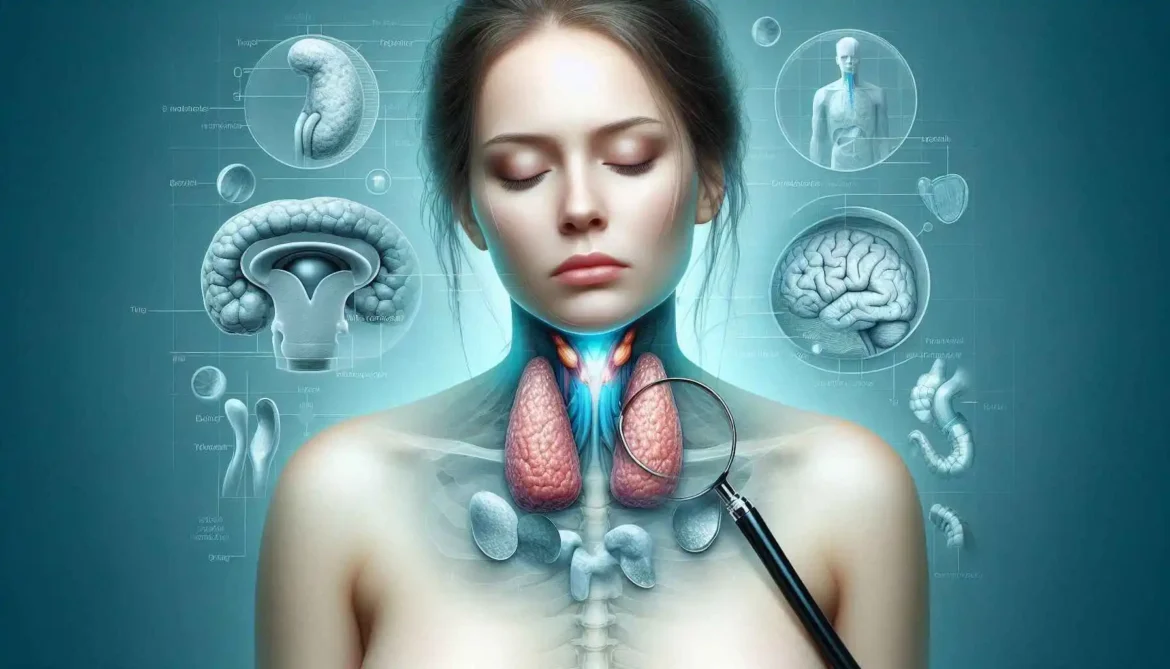
Thyroid Goiter: Causes, Diagnosis, and Effective Treatment Options
As we navigate our personal health journeys, we become attuned to the subtle signals our bodies send us. A new ache, persistent fatigue, or an unexpected change in our appearance can all be signs that something requires our attention. One such signal, which can be visually alarming, is the development of a swelling at the base of the neck. This condition is known as a goiter, and while its appearance can be unsettling, it is often a manageable and treatable condition.
In this comprehensive guide, we will explore the world of the thyroid gland to understand exactly what a goiter is. We will delve into its diverse causes, learn to recognize its symptoms, walk through the modern diagnostic process, and examine the range of effective treatments available today. Our goal is to demystify this common condition and empower you with the knowledge needed to approach it confidently.
What Exactly Is a Goiter?
Before we can understand a goiter, we must first appreciate the small but mighty gland from which it originates: the thyroid. Located in the front of the neck, just below the Adam’s apple, this butterfly-shaped gland is a crucial part of our endocrine system, the network of glands that produce and release hormones. The thyroid’s primary responsibility is to synthesize and secrete hormones, primarily thyroxine (T4) and triiodothyronine (T3), that regulate our body’s metabolism. Think of metabolism as the engine that powers all our bodily functions. These thyroid hormones influence a vast array of processes, including heart rate, body temperature, digestion, brain development (especially in children), muscle control, mood, and nearly every other metabolic process. They essentially tell our cells how quickly to use energy.
A goiter, in its simplest definition, is the abnormal enlargement of this vital thyroid gland. Imagine the thyroid swelling beyond its normal size, becoming visibly larger in the neck. It’s important to note that the term “goiter” describes the physical swelling of the thyroid; it is not a specific disease in itself, but rather a symptom or a sign of an underlying issue. A person with a goiter might have a thyroid gland that is producing too much hormone (hyperthyroidism, leading to a revved-up metabolism), too little hormone (hypothyroidism, causing a sluggish metabolism), or even the correct amount of hormone (euthyroidism, where the hormone levels are normal despite the enlarged gland). The enlargement itself is the body’s response to an underlying issue that is stimulating the thyroid to grow abnormally. This underlying cause could range from iodine deficiency to autoimmune conditions or even the presence of nodules within the gland. Therefore, discovering a goiter is just the first step; identifying the reason for the enlargement is the key to proper diagnosis and treatment.
The Root Causes: Why Do Goiters Develop?
The development of a goiter, an abnormal enlargement of the thyroid gland, can be attributed to several distinct underlying causes, with some occurring far more frequently than others. Identifying the root cause is paramount, as it’s the most critical determinant in charting the correct and effective course of treatment. Understanding the ‘why’ behind the goiter’s development is essential for targeted and successful management.
- Iodine Deficiency: On a global scale, iodine deficiency stands as the most prevalent cause of goiters. The thyroid gland critically relies on iodine to synthesize its essential hormones, triiodothyronine (T3) and thyroxine (T4). When the diet lacks sufficient iodine, the thyroid gland struggles to produce adequate amounts of these hormones, leading to hypothyroidism. In response to this deficiency, the pituitary gland in the brain releases an increased amount of Thyroid-Stimulating Hormone (TSH), acting as a signal to prompt the thyroid to work harder. This constant stimulation causes the thyroid cells to multiply excessively (hyperplasia) and the gland to grow in size (hypertrophy) in a desperate attempt to capture and utilize as much iodine from the bloodstream as possible. This adaptive response, while intended to compensate for the deficiency, ultimately results in the visible enlargement characteristic of a goiter.
- Autoimmune Conditions: In many regions of the world where iodine intake is generally sufficient, autoimmune diseases emerge as the leading cause of goiter development. These conditions involve the body’s immune system mistakenly attacking the thyroid gland, disrupting its normal function.
- Hashimoto’s Disease: This autoimmune condition involves the immune system erroneously targeting and damaging the thyroid gland. This progressive damage impairs the thyroid’s ability to produce hormones effectively, ultimately leading to hypothyroidism. The pituitary gland, sensing the low hormone levels, responds by releasing elevated levels of TSH, stimulating the thyroid in an attempt to boost hormone production. This chronic stimulation, however, contributes to the enlargement of the thyroid gland, resulting in a goiter.
- Graves’ Disease: In contrast to Hashimoto’s disease, Graves’ disease represents an autoimmune disorder that leads to overstimulation of the thyroid. In this condition, the immune system produces an abnormal antibody called thyroid-stimulating immunoglobulin (TSI) that mimics the action of TSH. This antibody binds to TSH receptors on thyroid cells, causing the thyroid to become excessively stimulated and produce an overabundance of thyroid hormones (hyperthyroidism). This overactivity and constant stimulation lead to the swelling characteristic of a goiter.
- Thyroid Nodules: Sometimes, within the thyroid gland, distinct lumps or masses develop. These can be either solid or fluid-filled and are referred to as thyroid nodules. The presence of a single nodule (solitary nodule) or multiple nodules (multinodular goiter) can disrupt the normal architecture of the thyroid gland and, if they grow significantly, cause the entire gland to become enlarged, resulting in a goiter. While most thyroid nodules are benign (non-cancerous), they should always be thoroughly evaluated by a healthcare professional to rule out any underlying malignancy or functional abnormalities.
- Pregnancy: The hormone human chorionic gonadotropin (hCG), which is produced in substantial amounts during pregnancy, can exert a mild stimulating effect on the thyroid gland. This stimulation can sometimes cause the thyroid to enlarge slightly, resulting in a temporary goiter. In most cases, this enlargement is mild and resolves spontaneously after childbirth.
- Thyroiditis: This term refers to inflammation of the thyroid gland, which can arise from various causes, including viral infections (like de Quervain’s thyroiditis) or autoimmune attacks (as seen in Hashimoto’s thyroiditis). The inflammation associated with thyroiditis can cause pain and swelling in the neck, leading to a temporary goiter. Depending on the underlying cause, thyroiditis can be associated with either hyperthyroidism (early stages) or hypothyroidism (later stages).
- Thyroid Cancer: Although a much less common cause compared to the other factors mentioned, a malignant tumor (cancer) within the thyroid gland can lead to swelling and enlargement of the gland, resulting in a goiter. The goiter may be the first noticeable sign of thyroid cancer, highlighting the importance of prompt evaluation of any thyroid enlargement.
“A goiter is a red flag. It tells you the thyroid is under some kind of stress. While many are harmless, they should never be ignored. A thorough evaluation can distinguish a benign, watch-and-wait situation from a condition that requires immediate medical intervention.” — Dr. Elena Christofides, M.D., F.A.C.E., Endocrinologist
Recognizing the Signs and Symptoms
The most obvious symptom of a goiter is a visible swelling in the neck, which can range from a small, barely noticeable lump to a very large and prominent mass. The size and growth rate of the goiter can vary depending on the underlying cause. While a visible swelling is a key indicator, other symptoms can arise, depending on the size of the goiter and whether it affects thyroid hormone production. It’s important to note that some goiters may be asymptomatic, especially in their early stages.
Symptoms Related to the Size of the Goiter (Compressive Symptoms):
When a goiter grows, it can exert pressure on surrounding structures in the neck, leading to what are known as compressive symptoms. These symptoms can significantly impact a person’s quality of life.
- A feeling of tightness or a “lump” in the throat: This sensation can be described as a general discomfort or pressure in the neck area. It might feel like something is pressing against the trachea (windpipe) or esophagus (food pipe). This sensation can be constant or intermittent.
- Difficulty swallowing (dysphagia): An enlarged goiter can physically compress the esophagus, making it difficult for food and liquids to pass through easily. Dysphagia can range from mild discomfort to a more severe inability to swallow solid foods, requiring dietary modifications. In severe cases, it can lead to aspiration pneumonia if food or liquid enters the lungs.
- Difficulty breathing (dyspnea), especially when lying on your back: When a goiter presses on the trachea, it can narrow the airway, making breathing more difficult. This is often more pronounced when lying down because gravity can further compress the trachea. Shortness of breath can occur with exertion or even at rest in severe cases. Stridor, a high-pitched whistling sound during breathing, may also be present, indicating significant airway obstruction.
- A persistent, dry cough: The enlarged goiter can irritate the trachea or surrounding tissues, triggering a chronic, non-productive cough. This cough is usually not associated with illness like a cold or flu.
- Hoarseness or other voice changes: The recurrent laryngeal nerve, which controls the vocal cords, runs close to the thyroid gland. A goiter can compress or irritate this nerve, leading to hoarseness, a breathy voice, or other alterations in vocal quality. In rare cases, more significant nerve damage can cause vocal cord paralysis.
Important Considerations:
It’s crucial to emphasize that the presence and severity of these symptoms vary significantly depending on the size, growth rate, and location of the goiter. Some individuals with large goiters may experience minimal symptoms, while others with smaller goiters may have more pronounced complaints. Any of these symptoms should prompt a visit to a healthcare professional for evaluation and diagnosis. Early detection and management can help prevent complications and improve outcomes.
Symptoms Related to Thyroid Function and Goiters:
A goiter, an enlargement of the thyroid gland, can sometimes be associated with either an underactive (hypothyroidism) or an overactive (hyperthyroidism) thyroid. The symptoms experienced depend largely on which of these conditions is present:
- If the goiter is associated with Hypothyroidism (Underactive Thyroid): When the thyroid gland doesn’t produce enough thyroid hormone, the body’s processes slow down. This can lead to a variety of symptoms, including:
- Fatigue: Feeling constantly tired and lacking energy, even after adequate rest.
- Unexplained Weight Gain: Difficulty losing weight or a tendency to gain weight without changes in diet or exercise.
- Sensitivity to Cold: Feeling colder than normal, even in moderately warm environments.
- Dry Skin: Skin that is rough, flaky, and itchy.
- Constipation: Infrequent bowel movements and difficulty passing stool.
- Depression: Persistent feelings of sadness, hopelessness, and loss of interest in activities.
- Other Possible Symptoms: Muscle weakness, joint pain, hair loss, a hoarse voice, and memory problems.
- If the goiter is associated with Hyperthyroidism (Overactive Thyroid): When the thyroid gland produces too much thyroid hormone, the body’s processes speed up. This can lead to a different set of symptoms, including:
- Unexplained Weight Loss: Losing weight despite maintaining or even increasing food intake.
- Rapid Heartbeat (Tachycardia): A noticeably fast or irregular heartbeat.
- Anxiety: Feeling nervous, restless, and easily agitated.
- Tremors: Shaking or trembling, often in the hands and fingers.
- Sweating: Excessive perspiration, even when not hot or active.
- Sleep Disturbances (Insomnia): Difficulty falling asleep or staying asleep.
- Other Possible Symptoms: Irritability, muscle weakness, heat sensitivity, frequent bowel movements, changes in menstrual cycles (in women), and bulging eyes (Graves’ disease).
Important Note: It’s crucial to remember that these symptoms can also be caused by other medical conditions. If you are experiencing any of these symptoms, it is important to consult with a healthcare professional for proper diagnosis and treatment. A goiter itself may not cause any symptoms unless it becomes very large and presses on the trachea (windpipe) or esophagus (food pipe), causing difficulty breathing or swallowing.
The Path to an Accurate Diagnosis of a Goiter
A goiter—an enlargement of the thyroid gland—can be a symptom of many different thyroid disorders, ranging from simple iodine deficiency to autoimmune disease or even thyroid cancer. Because the underlying cause determines the appropriate treatment, physicians follow a systematic, step‑by‑step diagnostic pathway that combines a careful clinical assessment with targeted laboratory and imaging studies. Below is an expanded, in‑depth look at each component of that pathway, plus a few additional evaluations that may be ordered when the initial work‑up raises questions.
1. Comprehensive Clinical Evaluation
| Element | What the clinician does | Why it matters |
| Detailed Medical History | • Onset, duration, and rate of growth of the neck swelling • Associated symptoms (e.g., heat intolerance, weight loss, fatigue, constipation, dysphagia, hoarseness, dyspnea) • Family history of thyroid disease or autoimmunity • Past radiation exposure to the head/neck, iodine intake, medication use (e.g., lithium, amiodarone, interferon) | Helps narrow the differential diagnosis (e.g., Graves disease vs. Hashimoto thyroiditis vs. iodine deficiency). |
| Physical Examination | • Palpation of the thyroid: size, consistency (soft, firm, rubbery), mobility, tenderness, presence of a bruit (suggesting hypervascularity) • Observation of any cervical lymphadenopathy • Assessment of tracheal deviation or compression • Evaluation of eye signs (exophthalmos) and dermal changes (pretibial myxedema) pertinent to Graves disease | Directly identifies the presence of a goiter and can hint at its nature (e.g., a nodular vs. diffuse enlargement). |
| Functional Maneuvers | • Ask the patient to swallow while the clinician feels the thyroid moving upward and downward • Perform the “Valsalva” maneuver to see if the goiter is compressible | Swallowing confirms that the mass is thyroid tissue; Valsalva helps differentiate thyroid from other neck masses (e.g., cysts, laryngoceles). |
2. Laboratory Assessment
| Test | Typical Reference Range* | Clinical Interpretation |
| Thyroid‑Stimulating Hormone (TSH) | 0.4–4.0 mIU/L (may vary by lab) | Low TSH → primary hyperthyroidism; high TSH → primary hypothyroidism; normal TSH with abnormal T4/T3 may indicate central (pituitary) disease. |
| Free Thyroxine (Free T4) | 0.8–1.8 ng/dL | Low free T4 with high TSH = hypothyroidism; high free T4 with suppressed TSH = hyperthyroidism. |
| Free Triiodothyronine (Free T3) | 2.3–4.2 pg/mL | Helpful when TSH is suppressed but free T4 is normal (T3‑toxicosis). |
| Thyroid Antibodies | – Anti‑Thyroid Peroxidase (Anti‑TPO) – Anti‑Thyroglobulin (Anti‑TG) – TSH‑Receptor Antibodies (TRAb) | Anti‑TPO/Anti‑TG positivity → autoimmune thyroiditis (most commonly Hashimoto). TRAb positivity → Graves disease (stimulating antibodies) or, rarely, blocking antibodies causing hypothyroidism. |
| Calcitonin (optional) | <10 pg/mL | Elevated in medullary thyroid carcinoma; ordered when there is a family history of MEN 2 or suspicious nodules. |
| Serum Calcium & PTH (if indicated) | Calcium 8.5–10.5 mg/dL, PTH 10–65 pg/mL | Hypercalcemia may suggest parathyroid co‑pathology, especially when a neck mass is large or invasive. |
| Iodine Status (Urinary Iodine Concentration) | 100–200 µg/L (adequate) | Useful in regions where iodine deficiency is still prevalent; low levels may explain diffuse goiter. |
*Reference ranges can differ between laboratories; always interpret results in the context of the specific assay used.
3. Imaging Studies
3.1. Thyroid Ultrasound (First‑Line Imaging)
| Feature Evaluated | What the Sonographer Looks For | Clinical Implication |
| Gland Dimensions | Longitudinal and transverse measurements of each lobe and isthmus | Determines whether the enlargement is mild (<20 mL) or substantial (>40 mL). |
| Echotexture | Homogeneous (diffuse) vs. heterogeneous (nodular) | Homogeneous enlargement often points to simple goiter or Graves; heterogeneous texture suggests Hashimoto or multinodular goiter. |
| Nodules | Number, size, composition (solid, cystic, mixed), margins, calcifications, halo, vascular pattern | The presence of solid, hypoechoic nodules with irregular margins or microcalcifications raises suspicion for malignancy (TI‑RADS or ATA risk categories). |
| Doppler Flow | Increased peripheral or internal vascular flow (hypervascular pattern) | Typical of Graves disease (“thyroid inferno”). |
| Cervical Lymph Nodes | Size, shape, hilum presence, echogenicity | Enlarged, loss‑of‑hilum nodes may suggest metastatic spread from a thyroid carcinoma. |
Why ultrasound is indispensable: It is painless, radiation‑free, inexpensive, and can be performed at the bedside. The high resolution enables detection of nodules as small as 2‑3 mm, which is essential for early cancer detection.
3.2. Complementary Imaging (when ultrasound is insufficient)



